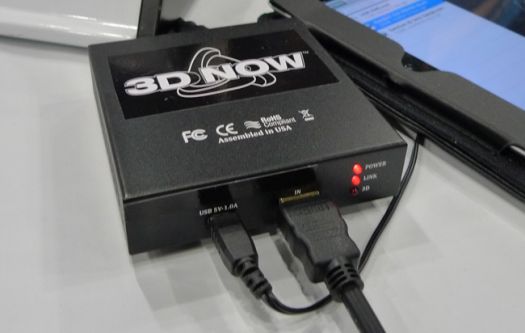Occasionally amidst the hubbub of CEDIA Expo (currently being held in Indianapolis), we come across cool new companies or products that we haven't heard of before; companies providing unique and valuable solutions, sometimes for problems we didn't even know existed. 3D Now is not one of those products.
What Does it Do?
The 3D Now converter box is positioned as a "revolutionary technology" that "converts any 2D HD display - old or new - to a stunning 1080p 3D experience." What does it actually do? The 3D Now "Theater" converter box takes the HDMI output of a 3D source component, such as a Blu-ray 3D player or 3D-capable set-top box, and converts it into a frame sequential 3D signal at 60 Hz (60 frames per second), alternating the left and right eye signal in the output.
Because the output signal is standard 1080p/60, it is compatible with many (but not all) pre-3D HDTVs. A separate emitter then synchronizes this 3D signal to a pair of compatible 3D glasses so that your brain can see the image in 3D.
Seems like a simple and elegant solution to bring 3D to that large audience of customers who bought HDTVs and projectors before the current 3D capabilities were available. Right? Unfortunately it's not that simple.
The problems with trying to add 3D capabilities to non 3D TVs are myriad. The first, most serious problem is flicker. All TVs create the illusion of motion by presenting a series of still images on the screen. If this series of images is presented quickly enough, it looks like realistic motion to our eyes and brains. If it's flashed too slowly, it produces flicker that can be extremely bothersome. Imagine flipping the lights on and off in a room 30 times a second. This is similar to the effect you get when watching a 3D signal on a non 3D-compatible TV through the 3D Now box. It's unsettling, headache-inducing, and difficult to watch. 30 frames per second is too slow to reproduce flicker-free, enjoyable and realistic reproduction of moving images.

The second problem is one of recreating fluid, realistic looking motion. Most movies are filmed and captured at 24 frames per second. Live sports are typically filmed and captured at 60 fields or 60 frames per second (1080i or 720p). Most current (non-3D) TVs convert these frame rates to a 60 Hz progressive signal using a process called 2:3 pulldown (for 24 frame/second sources) or de-interlacing (for interlaced sources). The 3D Now box chops this 60 Hz signal in half (to 30 Hz per eye). The end results is choppy, uneven motion. This is separate from the flicker already described.
Another problem with attempting to do 3D on a non 3D-capable display is that of crosstalk. If the LCD or plasma panel was designed without 3D in mind, it may not (in most cases will not) be able to refresh its image quickly enough to prevent the left image from lingering on screen and interfering with the right image (and vice versa). This results in ghosted images - doubled lines - that appear on screen where they should not. To support 3D without noticeable crosstalk, modern 3D-capable TVs were enhanced to support higher refresh rates, either with faster firing phosphors (in plasma TVs) or faster panel refresh rates and clever application of black frame insertion (on LCD and LED TVs).
The demos that the 3D Now folks had set up at CEDIA suffered from all of the above problems: major flicker, motion distortion (jitter and judder) and crosstalk. Also, on a 60 Hz LG plasma they used for a demo, colors were inaccurate and washed out. Was there a sense of depth to the 3D image? Absolutely. The 3D Now box did seem to deliver on at least part of its promise. But it was definitely not a high quality or enjoyable 3D experience.
Our advice to those who want to bring home 3D: don't waste your money on an inferior aftermarket solution. Take that money and instead put it toward a true 3D-capable television or projector. They haven't exactly been selling like gangbusters so the current price premium between a 3D-capable and non 3D-capable television is negligible, all other features and performance being equal. Do it right or don't bother.